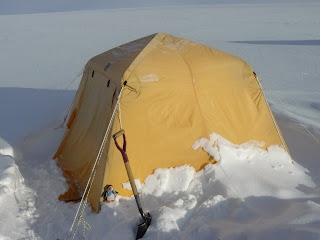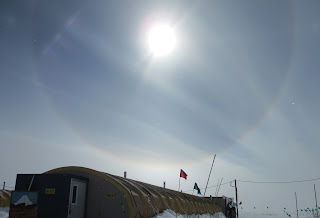Everyone involved in field work in Antarctica need to go through a "happy camper" school - a snow survival training. A group of us (eight total) were taken to the Ross ice shelf and
left there overnight. Well, first our instructor told us what to do ;)
The weather was magnificent both days and it felt like an incredibly fun hiking trip. Before we went to the field we talked in the classroom about the importance to be prepared for unexpected weather changes. Our instructor, Alasdair, worked as a tour guide and in search and rescue in many different places all over the world and he had many stories to share.
The first thing we needed to do - mark a path from our "camp central" to the outhouses. Since US Antarctic program continuously brings people out to the ice shelf - an "permanent" outhouses were installed. And what a view they have - Mt Erebus in the background.
The Sun was bright and the idea of putting flag every meter or so to mark the path seemed like an overkill. However, in the morning we woke up to a foggy weather, and couldn't see beyond several meters (only for a short time though) and flags were there to help orient us around.
Our camp consisted of two Scott tents, two different kinds of mountain tents, a kitchen and a few snow trenches people dug out. Here's how it looked from the distance:
A Scott tent is the same design as used by Scott's expeditions in earl 1900s. It is amazingly sturdy and can sustain crazy Antarctic winds. The floor of the tent is a separate piece of material, which I have never seen before, but it seems practical. The only disadvantage of a Scott tent - it is not particularly well isolated and it is colder then a mountain tent.
First we put up two Scott tents, making sure to secure them in the snow. A short bamboo stack is all we used, Alasdair showed us a couple of knots and taught us how to dig a hole to put the anchor in. Sides of Scott tent were also heaved down with snow.
After we were done with Scott tents we build a snow wall to protect smaller mountain tents from being blown away. We started a quarry and then used a "snow saw" (a regular saw actually) to cut out blocks. We managed to put up a wall really fast. Although not perfectly aligned, it was solid.
(April, Zozo, Masha, Mitch and Jenny by the newly constructed snow wall)
Here's a picture of our snow quarry - you can see shovels and saws we used and can sort off guess how/where the cutting was done. It is important to cut out through pristine part of the snow, so the area behind the quarry was off limits.
Upon completing a snow wall we put up a mountain tent behind it:
(Jeff in front of his tent, which is behind a snow wall)
The next task was to dig out a kitchen. We decided to do an island table in the middle first (and dig around it to allow us to stand up around it, While working on this design we thought it would be fun to carve sitting area out in the snow - so we ended up with three 2/3 seater benches around the table. We put the stove on the table and managed to have a great dinner as group. (A few hours later once we melted the snow for food!)
(April and Danette were working on getting the snow melted, while others worked on snow trenches)
(Water finally boiled! At this point we are almost done with snow trenches and are quite tired. We had dehydrated dinner available in our green "kitchen" bag)
Digging a snow trench was a lot of fun. Here's Zozo - picking out a spot to dig:
I have to admit though I did a rookie mistake and dug a really wide trench. You are supposed to completely cover the trench up with snow (or whatever material you can find. It is wise to dig a hole as narrow as possible - it will be easier to close it. You can later on widen your trench, a friend of mine actually dug a 2-person trench once, so your sleeping quarters can be as luxurious as you have energy for them to be! At the same time it will be really hard to get in and out.
Since the Sun was up and it was really warm, the snow started to melt and to fall apart. Cutting blocks wide enough for my trench was impossible, in fact even more narrow trenches had issues. Zozo and I decided to improvise and used banana sleds over the top:
(also mainly sitting in my pocket or on the snow, Zozo got really tired digging the trench and couldn't even stand up when I asked him to pose)
(Almost finished trench)
Now I have to admit defeat. Although I finished my trench and even brought my stuff inside and layed it out I decided not to sleep in there. I could get good sleep in, but the idea of waking up and going to the bathroom in the middle of the night freaked me out. In the hindsight, I probably should have made my trench a bit roomier, wider and deeper - maybe moving inside would be a little easier then. But from what I hear it was quite awkward to move around.
(My post somehow turns to the bathroom topic over and over, but here we go again. We were given pee bootles - regular water bottles designated for this purpose. The idea is to use it in the field if you don't have an outhouse to preserve the landscape as much as possible. Pee bootles also come handy if you are too lazy to get up and go to the camp outhouse in the middle of the night. Since my trench was somewhat narrow and unlike Zozo I'm not a boy, I doubted my ability to use the pee bottle inside a trench "without accidents" and opted out to sleep in a tent.)
Here's a photo of Mitch's trench - His entrance was actually really nice and narrow and he managed to be able to cut snow blocks wide enough (some block did collapse in the process since the snow was too warm):
(Zozo by Mitch's trench. Every trench was also designated by flags to make
sure people do not walk over it)
Sleeping in a mountain tent was warm. No, VERY WARM! The Sun is always out and the tent basically acts as a greenhouse. I opened all windows and left the door open and I was still rather warm in my super-warm sleeping bag. Which makes me feel so good about my upcoming trip to West Antarctica - I will likely be sleeping in a tent there as well.
In the morning we woke up around 6:30 am or so, boiled snow again for some oatmeal and tea and started disassembling our camp. We had to be ready by 8:30 am, when Alasdair came to pick us up and continue the survival training. All the trenches, the kitchen, and the quarry needed to be leveled up, the tents put away and all our stuff collected. The site looked like we were never there!
The rest of the morning we spent talking about snow survival. One of the exercises was scenario simulation. A scenario was - a member of our team went to the bathroom (about 50m away from the house we were in, marked by flags every meter or so). Bad weather came suddenly and we are now in a complete white out situation and our team member has not come back. What shall we do?
We started a rescue operation.
To simulate the complete white out conditions nobody could leave the house without a white bucket on their head. It is amazing how easy it is to loose the sense of direction once you can not see where you are going. The white bucket also prevents you from hearing well, so you can only talk to a person standing right next to you.
Our team failed to rescue the missing team member. It was only eight of us and we did not have a strong leader. We were also quite clueless about how to proceed and what technique would work best. Here's a picture of me being quite clueless:
I managed to find the first flag (thanks to the broom!), but went way of course in search for the second one. My partner Andy actually tried to steer me back – he could feel that I went in the wrong direction, but it was hard to understand his signals via rope and I couldn’t hear him at all. I eventually corrected myself (with a lot of help from Andy), but we ran out of time and got pulled back in by other team members, who were worried that we will get hypothermia (whiteout conditions are associated with high winds and low wind chill temperatures). I had a lot of ideas on what to do once I got back, but we ran out of time and had to go back to McMurdo.
What can I say - all in all I am a happy camper ;)
And so is Zozo:























































